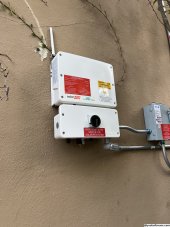I like the suggestion to slide the panels on the existing rails on the Southwest and Southeast-facing sections to add 3 more. There appears to be plenty of rail up there, maybe it was a rushed job, looks horrid but works out good in this case. You can add a total of 5 more if 2 are added to the Northwest roof too, albeit with lesser daily output for those.
Using the existing extra rails means you don't have to alter the conduit, and it keeps the parts list low. It might be necessary to pull another pair of conductors through the conduit if splitting the string becomes necessary.
Need to identify the model of the panels, optimizers, rails, panel-mount for rails, and rail mounting hardware for the optimizers.
Also need to identify if this is two or one string currently, and which panels are on what string if already 2, so the calculations can be done for adding more. With only 17 panels and the big chunk of Northwest facing modules, I'm going to guess it's all one string.
And, need to find out if you can get the inverter into optimizer pairing mode, or if it's locked out.
(Keep track of the serial numbers of the new optimizers into which position they are installed; you'll need that later for the App.)
As an additional benefit, you'll be inspecting the existing work done by the installation company and may decide, based on what you find, that you never want them near your home again. It happens...
Far as warranty goes, the equipment is unlikely to have issues, and even if something fails you might be able to pursue manufacturer warranty or for even less hassle just purchase a replacement (panel, optimizer, etc.) The inverter is the only expensive item. The main thing I'd be focused on for warranty is stuff caused by the installation itself - roof leaks, penetration problems, conduit, electric junctions, etc.
View attachment 168722




